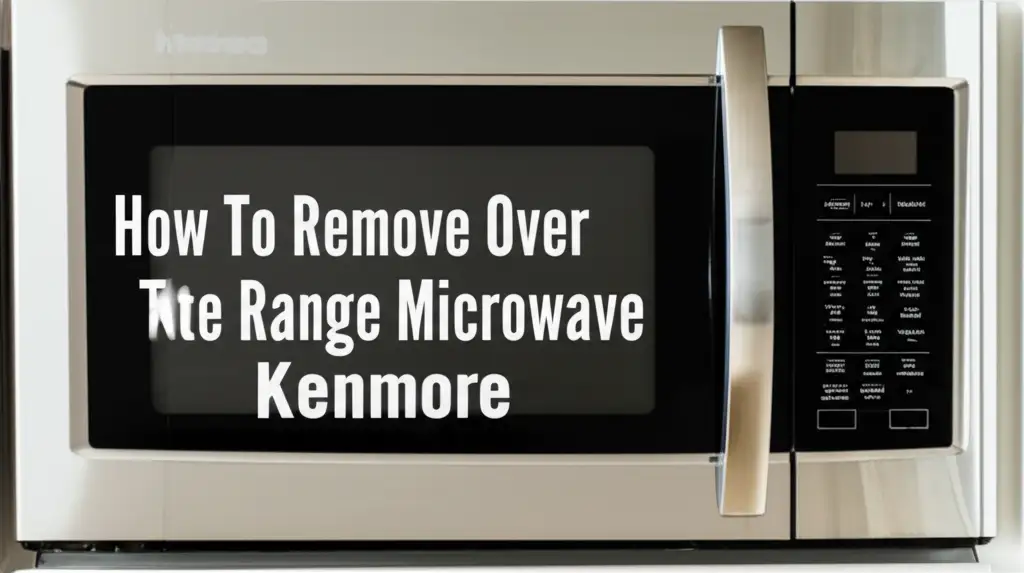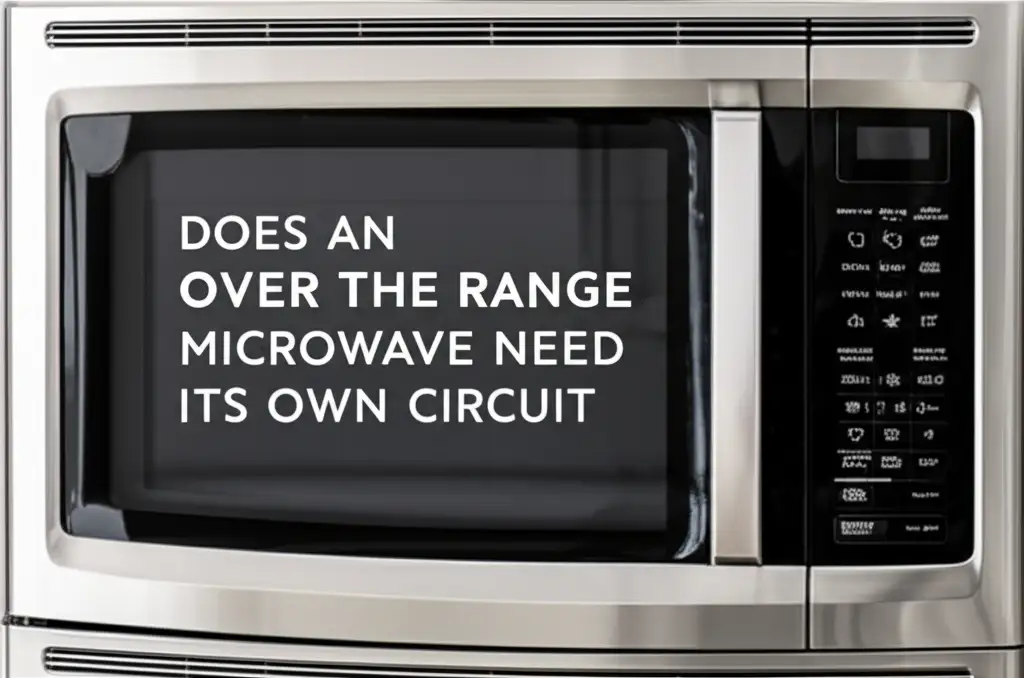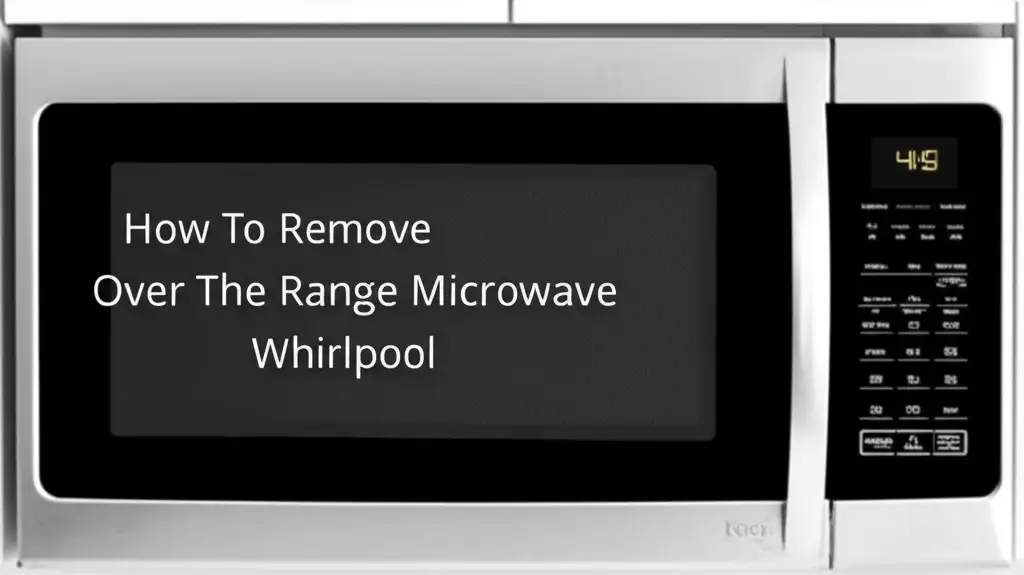· Todd Martin · Home Appliances · 13 min read
How To Remove Over The Range Microwave Kenmore

Easily Remove Your Kenmore Over-the-Range Microwave
Removing an old appliance can feel like a big project. You might be upgrading your kitchen or replacing a broken unit. If you own a Kenmore over-the-range microwave, you are in the right place. Taking it down requires careful steps.
I will guide you through the process. This article covers everything. We start with safety and end with proper disposal. You will learn the tools you need. I will show you how to disconnect and unmount your microwave safely. Get ready to tackle this task with confidence.
Takeaway:
- Always disconnect power before starting.
- Gather all necessary tools beforehand.
- Enlist a helper for safety during removal.
- Understand your microwave’s mounting system.
- Plan for proper disposal of the old unit.
Removing a Kenmore over-the-range microwave involves disconnecting power, unfastening cabinet screws, detaching it from its wall mounting plate, and carefully lowering the unit. Always ensure the appliance is unplugged and use a helper for safe handling due to its weight.
Prioritize Safety First: Essential Preparations for Kenmore Microwave Removal
Safety always comes first when working with electrical appliances. Before you touch your Kenmore over-the-range microwave, you must cut the power. This step prevents electric shock. I always make sure the power is off before I do anything else.
Go to your home’s main electrical panel. Find the circuit breaker labeled for your kitchen or microwave. Flip it to the “off” position. If labels are unclear, you can turn off the main breaker for the entire house. This ensures no power reaches the unit.
You should also wear appropriate safety gear. Heavy-duty gloves protect your hands. Safety glasses shield your eyes from dust or falling debris. A sturdy step stool or ladder gives you stable access to the microwave. Do not rush this preparation phase. It sets the stage for a safe and successful removal.
Confirm the power is off by trying to turn on the microwave. Press the buttons. If the display is dark and nothing turns on, the power is off. This simple check confirms your safety. Taking these precautions protects you and your home. You are now ready for the next steps.
Gather Your Tools: What You Need for a Smooth Kenmore Microwave Disassembly
Having the right tools makes any job easier. For your Kenmore over-the-range microwave removal, you will need a few common items. I always lay out all my tools before I begin. This saves time and frustration during the removal process.
You will need a Phillips head screwdriver and a flathead screwdriver. These are for various screws. Many microwaves use Phillips head screws for upper cabinet connections. You might need a drill with screwdriver bits for quicker work. A socket wrench set is also important. It helps with nuts holding the mounting bolts.
A sturdy ladder or step stool is a must. You need to reach the top of the microwave and the cabinet above it safely. A utility knife or box cutter can help if you need to cut any caulk or sealant. Have a small container ready for screws and parts. This stops them from getting lost. A voltage tester can confirm power is off, adding another layer of safety. Always use tools that are in good condition.
Having a helper is not a tool, but it is essential. Over-the-range microwaves are heavy. They can weigh 60 pounds or more. One person holds the weight while the other removes fasteners. This two-person approach prevents injury and damage to the appliance or your kitchen. Do not try to lift it alone.
Locating Fasteners and Connections: Detaching Your Kenmore Microwave
Once the power is off and your tools are ready, you can start detaching the microwave. Kenmore over-the-range microwaves generally connect in a few key places. Knowing where to look helps you work efficiently. I start by identifying all connection points.
First, open the upper cabinet door directly above the microwave. You will find mounting screws here. These long bolts go through the bottom of the cabinet and into the top of the microwave. Use your Phillips head screwdriver or socket wrench to loosen and remove these. There are usually two or three of these screws. Keep them safe in your parts container. These screws carry most of the microwave’s weight from the top.
Next, locate the power cord. It typically plugs into an outlet inside the cabinet above the microwave. Unplug it completely. Some installations might have a hardwired connection. If your Kenmore microwave is hardwired, you will need to turn off the power at the breaker. Then disconnect the wires inside a junction box. If you are unsure about wiring, consult an electrician. You can learn more about if can an over-the-range microwave be hardwired.
You will also find the ventilation system. Over-the-range microwaves can vent in different ways. They might vent out the top through the cabinet, out the back wall, or recirculate air. If it vents outside, you will see a duct connection. This is often a metal flange. You might need to disconnect this duct. For models that vent out the back, the vent often comes out when the microwave pulls away. Understanding how your model vents helps with removal. Getting familiar with how to install over-the-range microwave with vent can give you insights into its connections.
Finally, look for the wall mounting plate. This metal plate is on the wall behind the microwave. It supports the bottom back part of the unit. The microwave hooks onto this plate. You cannot remove the plate until the microwave is off the wall. The microwave usually rests on hooks or tabs on this plate. Once the top screws are out, the microwave will pivot down slightly. It will then lift off these bottom hooks. This is where your helper becomes vital.
Support and Lowering: Safely Removing the Kenmore Microwave Unit
This is the most critical step for safety. The microwave is heavy. It needs proper support as you remove the last fasteners. I always have my helper ready for this stage. They stand prepared to take the weight.
With the top mounting screws removed and the power unplugged, the microwave is almost free. The microwave is now hanging by its bottom hooks on the wall mounting plate. Your helper should stand directly in front of the microwave. They need to grip the bottom securely. Their job is to support the full weight of the unit.
You, as the person removing the microwave, will then lift the front of the microwave slightly. This lifts the bottom back edge off the mounting plate hooks. Once it clears the hooks, you and your helper can carefully tilt the microwave forward and slowly lower it. Make sure you lower it straight down. Do not twist or pull too hard. This prevents damage to the microwave or your cabinets.
Lower the microwave onto a padded surface. You can use old blankets or cardboard on the floor or a sturdy table. This protects both the microwave and your floor. Take a moment to rest once the unit is down. Moving heavy appliances requires good technique. You might find it helpful to think about how to install an over-the-range microwave in reverse. This gives you a clear mental picture of how it connects and disconnects.
After the microwave is safely on the floor, you can remove the wall mounting plate. This plate is usually secured with several screws to the wall studs. You will need your Phillips head screwdriver or socket wrench for this. You might also remove any remaining vent ducting. Now your space is clear.
Cleaning and Preparing the Space: After Your Kenmore Microwave is Gone
After removing the Kenmore over-the-range microwave, your wall and cabinets might need some attention. Grease and grime often build up behind and above these appliances. Cleaning this area is important. It prepares the space for a new microwave or other use.
First, inspect the wall and cabinet surfaces. You will likely find grease splatters. Use a strong degreaser or a mixture of dish soap and warm water. Wipe down all surfaces thoroughly. Pay close attention to the area where the microwave sat. This area often collects the most residue. A clean surface ensures better adhesion if you paint or install something new.
Check for any damage to the wall or cabinet. The mounting plate screws can sometimes leave marks. If you are not installing a new microwave, you might need to patch screw holes. Use spackle or wall putty for this. Sand it smooth once dry. Then, you can paint the area to match your kitchen. If you plan to install a new microwave, ensure the wall is sturdy. The new mounting plate will need a solid base.
Consider your plans for the empty space. Will you install a new microwave? Will you put in a range hood? Or will you add more cabinet space? Planning ahead helps you prepare the area correctly. If you are installing a similar microwave, make sure the new mounting plate aligns. If not, you may need to patch and paint. Cleaning the area now saves time later. It makes the next step in your kitchen update smoother.
Disposing of Your Old Kenmore Microwave: Responsible Options
You have successfully removed your old Kenmore over-the-range microwave. Now you face the question of disposal. You cannot just throw it in the regular trash. Appliances like microwaves contain materials that need special handling. Responsible disposal protects the environment.
Many cities offer appliance recycling programs. Check with your local waste management department. They can tell you about specific dates for bulk trash pickup. They might also list local recycling centers that accept microwaves. Some centers charge a small fee. Others take them for free. You can often find this information on your city’s website.
Retailers often offer haul-away services. If you bought a new microwave, the delivery company might take your old one away. Ask about this service when you purchase your new appliance. Sometimes it is included. Other times it is an added cost. This is a convenient option. It saves you the trip to a recycling center.
Junk removal services are another option. Companies specialize in picking up large items. They charge a fee, but they handle all the heavy lifting and proper disposal. This can be a good choice if you have other large items to get rid of. Consider your options for how to dispose of over the range microwave to make the best choice for you.
Lastly, consider donating your microwave if it still works. Many charities accept working appliances. They can give it to families in need. This is a great way to give your old appliance a second life. Check with local charities or thrift stores. Always confirm they accept microwaves and that yours is in good condition.
Troubleshooting Common Challenges During Kenmore Microwave Removal
Removing an appliance can sometimes present unexpected challenges. Even with careful planning, things can go wrong. Knowing how to handle common issues can save you time and frustration. I have faced some of these problems myself.
One common issue is stuck screws. Over time, screws can corrode or strip. If a screw is stuck, first try penetrating oil. Spray it on the screw head and wait a few minutes. This can loosen rust. If the screw head is stripped, use a screw extractor kit. These kits help you get a grip on damaged screws. Sometimes, you might need to carefully drill out a stripped screw.
Another challenge is the weight of the microwave. As I mentioned, these units are heavy. If you do not have a helper, you might struggle. You can use a stack of sturdy boxes or books to support the microwave’s weight as you remove the last fasteners. Slide the microwave onto the support. Then, you can slide it off the support and onto the floor. This method requires more care. It is still safer than trying to support it alone.
Ventilation ducts can also cause trouble. If your Kenmore microwave vents outside, the duct might be difficult to disconnect. Sometimes, the duct is sealed with tape or caulk. Use your utility knife to cut through any sealant. Wiggle the duct to loosen it. If it is a rigid metal duct, you might need to unscrew it from the wall or ceiling.
Lastly, sometimes the power outlet is not inside the cabinet. It might be behind the microwave. This makes unplugging harder. In this case, definitely ensure the circuit breaker is off. You might need to gently pull the microwave out a few inches to reach the plug. Remember to communicate clearly with your helper during this step. While a Kenmore microwave has specific mounting, general tips for removing an over-the-range microwave often apply across brands.
FAQ Section
Q1: Is it hard to remove a Kenmore over-the-range microwave?
Removing a Kenmore over-the-range microwave is a manageable DIY project. It requires careful planning and the right tools. The main difficulty comes from the microwave’s weight and working in a tight space. Having a second person to help with lifting makes the job much easier and safer.
Q2: Do all over-the-range microwaves remove the same way?
Most over-the-range microwaves, including Kenmore, follow a similar removal process. They typically have screws securing them from the upper cabinet and hook onto a wall mounting plate. Differences might exist in power cord location or specific ventilation connections. General steps remain consistent.
Q3: What if my Kenmore microwave is hardwired?
If your Kenmore microwave is hardwired, you must turn off power at the circuit breaker. Then, open the junction box, usually located inside the cabinet above the microwave. Carefully disconnect the wires inside this box. If you are not comfortable with electrical work, contact a qualified electrician for this step.
Q4: How much does a Kenmore over-the-range microwave weigh?
Kenmore over-the-range microwaves typically weigh between 50 and 80 pounds. The exact weight depends on the model and features. This weight makes it challenging for one person to remove the unit safely. Always use a helper to prevent injury and damage.
Q5: Can I remove it by myself?
I strongly advise against removing an over-the-range microwave by yourself. The weight and awkward size make it dangerous. You risk injury to yourself, damage to your cabinets, or dropping the appliance. A helper is essential to safely support and lower the unit from its mounted position.
Q6: What is a mounting plate?
A mounting plate is a strong metal bracket. It attaches to the wall studs behind the microwave. The bottom rear of the over-the-range microwave hooks onto this plate. This plate supports most of the microwave’s weight from below. The top screws from the cabinet secure the unit from above.
Conclusion
Removing your Kenmore over-the-range microwave can seem daunting. However, it is a straightforward task with proper preparation and safety measures. You have learned about disconnecting power, gathering tools, and finding fasteners. We covered how to safely lower the unit and clean the space. You also know about responsible disposal options.
Always remember that safety is paramount. Do not rush any step. Enlist a helper for the lifting part. Following these steps helps ensure a smooth removal process. You now have the knowledge and confidence to tackle this project yourself. Enjoy your newly updated kitchen space!
- kenmore microwave removal
- over the range microwave
- DIY appliance removal
- kitchen appliance repair
- Kenmore appliance





